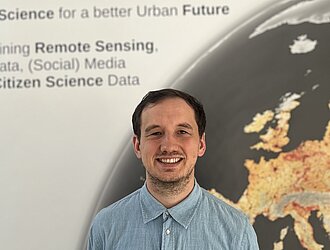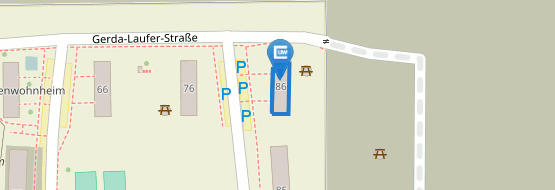Dr. John Friesen
Department of Remote Sensing
![]() +49 931 31-87996
+49 931 31-87996
john.friesen@uni-wuerzburg.de
Institute for Geography and Geology
Department for Remote Sensing
John Skilton Str. 4a
97074 Würzburg
Main research areas and interests
- Characterization of spatial and temporal changes in settlement structures (especially informal settlements)
- Population estimation and analysis
- Analysis and resilience assessment of supply infrastructures (water or health care)
- Equation-, data-driven and agent-based modeling of settlement processes
- Modeling of cardiovascular processes and diseases
Scientific career
since 2024 Co-lead of a main project in EO4CAM
2021-2024 Group leader "Urbanization and Infrastructure" at the Institute of Fluid Systems at TU Darmstadt
05/2021 PhD (Dr.-Ing.) Topic: Modeling and analysis of urban informal settlements for infrastructural planning
since 2020 Lectures at the DHBW Karlsruhe
since 2020 studies of human medicine at the Goethe University Frankfurt
2016-2021 Research assistant at the Institute for Fluid Systems Engineering at TU Darmstadt
2014-2016 studies of general mechanical engineering with a specialization in biomedical engineering at RWTH Aachen University (M. Sc.)
2010-2013 studies of mechanical engineering at the TU Darmstadt (B. Sc.)
Publications
Current list on Google Scholar
https://scholar.google.de/citations?user=S4LstwoAAAAJ&hl=de&oi=ao
-
. (2025): The world’s largest cities under climate change and their adaptive capacity to rising heat. In: Scientific Reports, 15 (1), 32671.
-
. (2025): Bibliometric and scoping study of research on urban deprived areas and slums. In: Discover Cities, 2 (1), 71.
-
. (2025): Differences in walking access to healthcare facilities between formal and informal areas in 19 sub-Saharan African cities. In: Communications Medicine, 5 (1), 41.
-
. (2024): The unseen population: {Do} we underestimate slum dwellers in cities of the {Global} {South}?. In: Habitat International, 148, 103056.
-
. (2024): Do resilience metrics of water distribution systems really assess resilience? {A} critical review. In: Water Research, 248, 120820.
-
. (2023): Methods to assess spatio-temporal changes of slum populations. In: Cities, 143, 104582.
-
. (2023): Challenges in identifying simple pattern-forming mechanisms in the development of settlements using demographic data. In: Physical Review E, 107 (6), 064305.
-
. (2023): Dynamic {Loading}—{A} {New} {Marker} for {Abdominal} {Aneurysm} {Growth}?. In: Medicina, 59 (2), 404.
-
. (2023): Modeling and {Validation} of {Residential} {Water} {Demand} in {Agent}-{Based} {Models}: {A} {Systematic} {Literature} {Review}. In: Water, 15 (3), 579.
-
. (2023): Towards a {Link} between {Quantitative} and {Qualitative} {Sciences} to {Understand} {Social} {Systems} {Using} the {Example} of {Informal} {Settlements}. In: Entropy, 25 (2), 262.
-
. (2021): A {Method} for {Modeling} {Urban} {Water} {Infrastructures} {Combining} {Geo}-{Referenced} {Data}. In: Water, 13 (16), 2299.
-
. (2021): Comparison of existing aneurysm models and their path forward. In: Computer Methods and Programs in Biomedicine Update, 1, 100019.
-
. (2020): Spatial {Analysis} of {Settlement} {Structures} to {Identify} {Pattern} {Formation} {Mechanisms} in {Inter}-{Urban} {Systems}. In: ISPRS International Journal of Geo-Information, 9 (9), 541.
-
. (2020): {COVID}-19 and {Slums}: {A} {Pandemic} {Highlights} {Gaps} in {Knowledge} {About} {Urban} {Poverty}. In: JMIR Public Health and Surveillance, 6 (3), e19578.
-
. (2020): Slums, {Space}, and {State} of {Health}—{A} {Link} between {Settlement} {Morphology} and {Health} {Data}. In: International Journal of Environmental Research and Public Health, 17 (6), 2022.
-
. (2019): Size distributions of slums across the globe using different data and classification methods. In: European Journal of Remote Sensing, 52 (sup2), 99-111.
-
. (2019): Similar size of slums caused by a {Turing} instability of migration behavior. In: Physical Review E, 99 (2), 022302.
-
. (2018): Determining {Factors} for {Slum} {Growth} with {Predictive} {Data} {Mining} {Methods}. In: Urban Science, 2 (3), 81.
-
. (2018): The similar size of slums. In: Habitat International, 73, 79-88.
-
. (2018): A {Holistic} {Concept} to {Design} {Optimal} {Water} {Supply} {Infrastructures} for {Informal} {Settlements} {Using} {Remote} {Sensing} {Data}. In: Remote Sensing, 10 (2), 216.




